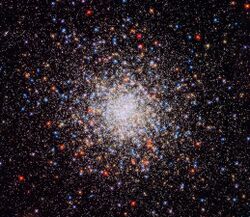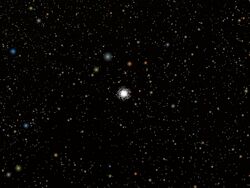Astronomy:NGC 6541
From HandWiki
Short description: Globular cluster in the constellation Corona Australis
| NGC 6541 | |
|---|---|
 NGC 6541, imaged by the Hubble Space Telescope | |
| Observation data (J2000 epoch) | |
| Class | III[1] |
| Constellation | Corona Australis |
| Right ascension | 18h 08m 02.36s[2] |
| Declination | –43° 42′ 53.6″[2] |
| Distance | 22.8 kly (7.0 kpc)[3] |
| Apparent magnitude (V) | 6.3 |
| Apparent dimensions (V) | 15′ |
| Physical characteristics | |
| Absolute magnitude | -8.52 |
| Mass | 5.72×105[4] M☉ |
| Metallicity | [math]\displaystyle{ \begin{smallmatrix}\left[\ce{Fe}/\ce{H}\right]\end{smallmatrix} }[/math] = –1.53[5] dex |
| Estimated age | 12.93 Gyr[5] |
| Other designations | Caldwell 78 |
NGC 6541 (also known as Caldwell 78) is a globular cluster in the southern constellation of Corona Australis. It is estimated to be around 14 billion years old.[6]
The globular cluster was discovered by Niccolò Cacciatore at the Palermo Astronomical Observatory, Sicily, on March 19, 1826. It was independently found by James Dunlop on July 3, 1826.
The cluster is relatively small, having just 94 blue straggler stars.[7]
References
- ↑ Shapley, Harlow; Sawyer, Helen B. (August 1927), "A Classification of Globular Clusters", Harvard College Observatory Bulletin 849 (849): 11–14, Bibcode: 1927BHarO.849...11S.
- ↑ 2.0 2.1 Goldsbury, Ryan et al. (December 2010), "The ACS Survey of Galactic Globular Clusters. X. New Determinations of Centers for 65 Clusters", The Astronomical Journal 140 (6): 1830–1837, doi:10.1088/0004-6256/140/6/1830, Bibcode: 2010AJ....140.1830G.
- ↑ Paust, Nathaniel E. Q. et al. (February 2010), "The ACS Survey of Galactic Globular Clusters. VIII. Effects of Environment on Globular Cluster Global Mass Functions", The Astronomical Journal 139 (2): 476–491, doi:10.1088/0004-6256/139/2/476, Bibcode: 2010AJ....139..476P.
- ↑ Boyles, J. et al. (November 2011), "Young Radio Pulsars in Galactic Globular Clusters", The Astrophysical Journal 742 (1): 51, doi:10.1088/0004-637X/742/1/51, Bibcode: 2011ApJ...742...51B.
- ↑ 5.0 5.1 Forbes, Duncan A.; Bridges, Terry (May 2010), "Accreted versus in situ Milky Way globular clusters", Monthly Notices of the Royal Astronomical Society 404 (3): 1203–1214, doi:10.1111/j.1365-2966.2010.16373.x, Bibcode: 2010MNRAS.404.1203F.
- ↑ O'Meara, Stephen James (2011). Deep-Sky Companions: The Secret Deep. Cambridge, United Kingdom: Cambridge University Press. p. 322. ISBN 978-0521198769. https://books.google.com/books?id=v859bKO0A4gC&pg=PA322.
- ↑ Raso, S.; Ferraro, F. R.; Dalessandro, E.; Lanzoni, B.; Nardiello, D.; Bellini, A.; Vesperini, E. (2017), "The "UV-route" to Search for Blue Straggler Stars in Globular Clusters: First Results from theHSTUV Legacy Survey", The Astrophysical Journal 839 (1): 64, doi:10.3847/1538-4357/aa6891, Bibcode: 2017ApJ...839...64R
External links
- NGC 6541 at SEDS NGC objects pages
- NGC 6541 at DOCdb (Deep Sky Observer's Companion)
- NGC 6541 on WikiSky: DSS2, SDSS, GALEX, IRAS, Hydrogen α, X-Ray, Astrophoto, Sky Map, Articles and images
Coordinates: ![]() 18h 08m 02s, −43° 53′ 00″
18h 08m 02s, −43° 53′ 00″
 |


